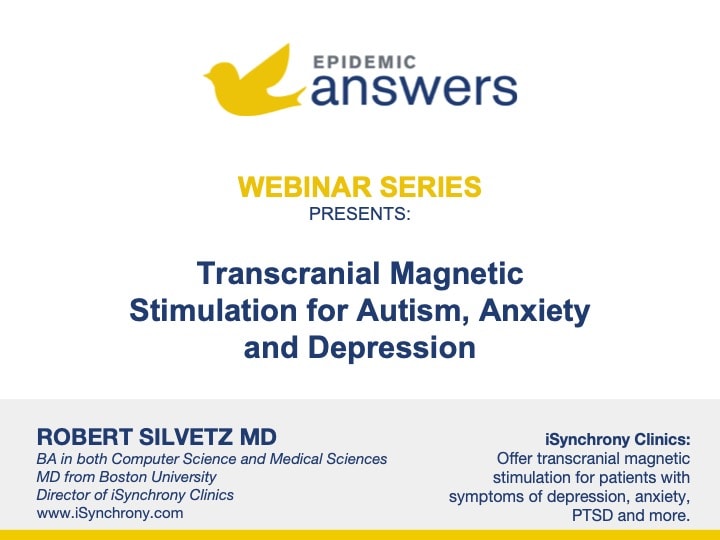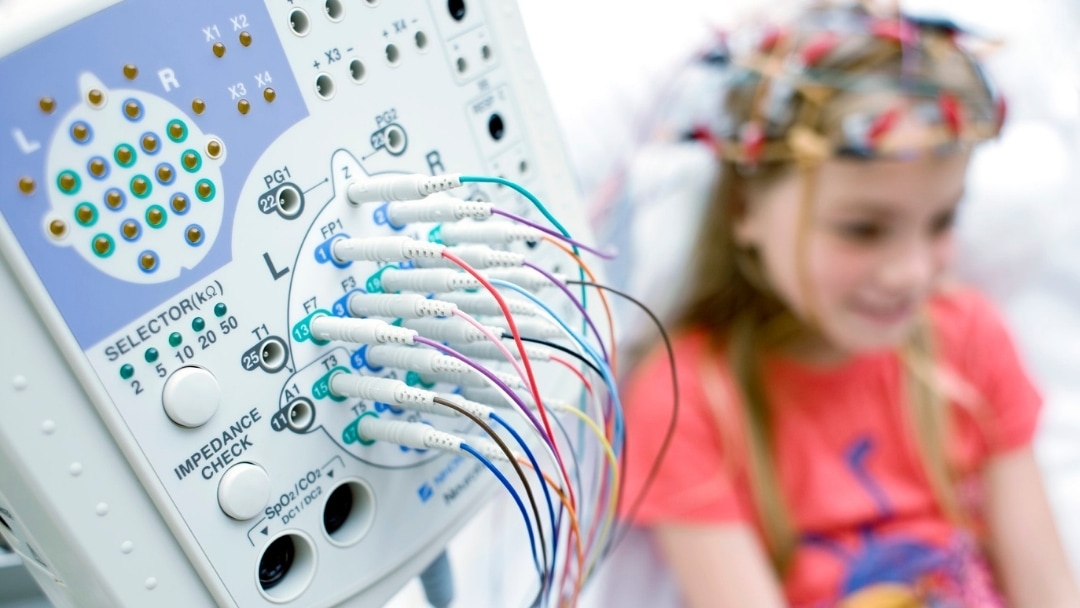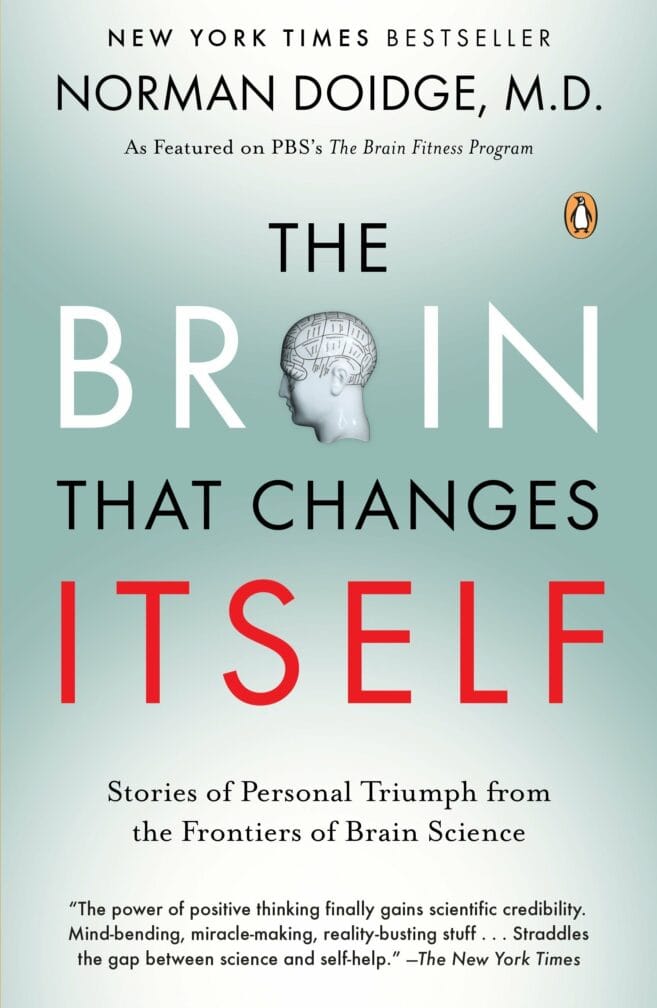We interviewed Raymond Escalona MD about neuroplasticity and how to fix a broken brain with a functional-medicine approach. You can watch the replay below. Please note that you will be asked to provide your email address at the 30-minute mark to continue viewing the replay.
What Is Neuroplasticity?
Neuroplasticity is the concept that the brain can change in structure or function in response to experience. It stands in contrast to the older theory of localization in which researchers believed that only a certain part of the brain was responsible for a specific function.
Although neuroplasticity was first proposed in the late 19th century, foundational research began in earnest in the 1980’s with the work of Paul Bach-Y-Rita’s sensory substitution theory. Dr. Bach-Y-Rita’s experiments showed that parts of the brain that were initially only thought to control one function or sense could, through repetition, be trained to compensate for the function of a damaged part of the brain. Norman Doidge MD popularized the concept of neuroplasticity to the masses with his book, The Brain That Changes Itself: Stories of Personal Triumph from the Frontiers of Brain Science.
In This Webinar
Dr. Escalona helped us answer the following questions in this webinar:
- What is neuroplasticity?
- How can a functional-medicine approach help to heal a broken brain?
- How does looking at a broken brain through the lens of mitochondrial dysfunction help us understand how to heal the brain?
- What is the sequence of interventions for healing a child with autism, ADHD, learning disabilities, Sensory Processing Disorder and other neurological conditions?
- Which supplements and interventions have the most evidence-based medicine backing them up?
- What are some therapies that can help heal a broken brain?
Resources Mentioned in This Webinar
Here are some of the resources mentioned in this webinar:
- Dr. Escalona’s Facebook group: https://www.facebook.com/groups/686080273046754/
- SmartDNA GUT Spectrum Detector™
- Webinar replay: Neurodevelopmental Genomics for Autism, ADHD and SPD with Heather Way PhD
- IntelxxDNA
- Hardy Nutritionals
- The Mood Cure: The 4-Step Program to Take Charge of Your Emotions–Today
- Avmacol® sulforaphane
- Webinar replay: Obstructive Sleep Apnea and ADD/ADHD
- Hyperbaric Oxygen Therapy
- Webina replay: ALF Orthodontics with James Bronson DDS PC
- Neurofeedback, LORETA, QEEG, LENS
- Low-glutamate diet
- Webinar replay: Neurofeedback for ADHD, Anxiety, OCD and Mood
- Vielight
- Push the Rock: Second Chances on the Road to Kilimanjaro
About Raymond Escalona MD
Raymond Escalona is a graduate of the MD-MBA program from the Ateneo School of Medicine and Public Health. He then took further studies at Bastyr University California completing a Masters in Nutrition for Wellness.
In 2019 he completed further training at the Institute for Functional Medicine elevating him to be one of the first certified Functional Medicine practitioners in Southeast Asia and the first to undergo clinical mentorship also in San Diego, California.
He specializes as a medical detective and focuses only on complex chronic disease management because he underwent special training in autism, autoimmune diseases and neuroplasticity.

He has been an educator in Southeast Asia for more than eight years and has lectured in over 400 venues across the region. He co-founded organizations and companies that develop and deliver nutrition and lifestyle education and implementation programs helping bridge the scientific knowledge gap between patients and practitioner communities across all socio-economic classes.
Apart from his clinical practice, Dr. Raymond currently works as a technical advisor and consultant to government, non-government and corporate organizations under the categories of nutrition, lifestyle change, integrative health and wellness projects. He hopes that through all these efforts we can one day see an end to chronic disease.
Disclaimer
This webinar is not a substitute for medical advice, treatment, diagnosis, or consultation with a medical professional. It is intended for general informational purposes only and should not be relied on to make determinations related to treatment of a medical condition. Epidemic Answers has not verified and does not guaranty the accuracy of the information provided in this webinar.
Still Looking for Answers?
Visit the Epidemic Answers Practitioner Directory to find a practitioner near you.
Join us inside our online membership community for parents, Healing Together, where you’ll find even more healing resources, expert guidance, and a community to support you every step of your child’s healing journey.
Sources & References
American Academy of Pediatrics. Biofeedback now a “Level 1 — Best Support” Intervention for Attention & Hyperactivity Behaviors. Evidence-based Child and Adolescent Psycho-social Interventions. 2012 Oct 5.
Arns, M., et al. Efficacy of neurofeedback treatment in ADHD: the effects on inattention, impulsivity and hyperactivity: a meta-analysis. Clinical EEG and Neuroscience, 40(3), 180-189.
Bach-Y-Rita, P. Brain plasticity as a basis for recovery of function in humans. Neuropsychologia. 1990;28(6):547-54.
Bach-Y-Rita, P. Is it possible to restore function with two percent surviving neural tissue? J Integr Neurosci. 2004 Mar;3(1):3-6.
Bach-Y-Rita, P. Theoretical and practical considerations in the restoration of function after stroke. Top Stroke Rehabil. 2001 Autumn;8(3):1-15.
Barnhill, E. Neural connectivity, music, and movement: a response to Pat Amos. Front Integr Neurosci. 2013 Apr 24;7:29.
Bartscherer, et al. Interactive metronome training for a 9-year-old boy with attention and motor coordination difficulties. Physiother Theory Pract. Oct-Dec 2005;21(4):257-69.
Bell, C., et al. The Effect of the MNRI Method on Neurotransmitter Biomarkers of Individuals with Neurodevelopmental Disorders. Neuroscience and Medicine. 2019.
Beauregard, M., et al. Functional magnetic resonance imaging investigation of the effects of neurofeedback training on neural bases of selective attention and response inhibition in children with attention-deficit/hyperactivity disorder. Applied Psychophysiology and Biofeedback, 2006 Mar;31(1):3-20.
Chekhchoukh, A., et al. Influence of sparkle and saccades on tongue electro-stimulation-based vision substitution of 2D vectors. Acta Biotheor. 2012 Jun;60(1-2):41-53.
Chiu, H.J., et al. Surface electroencephalographic neurofeedback improves sustained attention in ADHD: a meta-analysis of randomized controlled trials. Child Adolesc Psychiatry Ment Health. 2022 Dec 19;16(1):104.
Cho, H., et al. Effects of Action Observation Training with Auditory Stimulation on Static and Dynamic Balance in Chronic Stroke Patients. J Stroke Cerebrovasc Dis. 2020 May;29(5):104775.
Contestabile, A., et al. Lithium rescues synaptic plasticity and memory in Down syndrome mice. J Clin Invest. 2013 Jan;123(1):348-61.
Cosper, S.M., et al. Interactive Metronome training in children with attention deficit and developmental coordination disorders. Int J Rehabil Res. 2009 Dec;32(4):331-6.
Danilov, Y.P., et al. Efficacy of electrotactile vestibular substitution in patients with peripheral and central vestibular loss. J Vestib Res. 2007;17(2-3):119-30.
Deiss, T., et al. Physiological Markers and Reflex Pattern Progression in Individuals with Neurodevelopmental Deficits Utilizing the MNRI Method. Neuroscience and Medicine. 2019.
Deroy, O., et al. Reading the World through the Skin and Ears: A New Perspective on Sensory Substitution. Front Psychol. 2012 Nov 7:3:457.
Dudek, E., et al. The efficacy of real-time functional magnetic resonance imaging neurofeedback for psychiatric illness: A meta-analysis of brain and behavioral outcomes.
Neurosci Biobehav Rev. 2021 Feb;121:291-306.
Duric, N.S., et al. Neurofeedback for the treatment of children and adolescents with ADHD: A randomized and controlled clinical trial using parental reports. BMC Psychiatry, 2012 Aug 10;12:107.
Gani, C., et al. Long term effects after feedback of slow cortical potentials and of theta-beta-amplitudes in children with attention-deficit/hyperactivity disorder. International Journal of Bioelectromagnetism, 2008; 10, 4, 209 -232.
Gevensleben, H., et al. (2009). Is neurofeedback an efficacious treatment for ADHD?: A randomized controlled clinical trial. Journal of Child Psychology and Psychiatry, 2009 Jul;50(7):780-9.
Grigg, T.M., et al. Retained primitive reflexes: Perceptions of parents who have used Rhythmic Movement Training with their children. J Child Health Care. 2018 Sep;22(3):406-418.
Grzywniak, C. Integration exercise programme for children with learning difficulties who have preserved vestigial primitive reflexes. Acta Neuropsychologica. 2017;15(3).
Hardy, M.W., et al. Rhythm, movement, and autism: using rhythmic rehabilitation research as a model for autism. Front Integr Neurosci. 2013 Mar 28;7:19.
Herbert, J., et al. Crawling is associated with more flexible memory retrieval by 9-month-old infants. Dev Sci. 2007 Mar;10(2):183-9.
Hong, H.J., et al. Effect of Rhythmic Movement Program to Improve Walking Ability for Elderly Patients with Stroke. Indian Journal of Science and Technology. 2016 Jul;9(26).
Iverson, J.M. Developing language in a developing body: the relationship between motor development and language development. J Child Lang. 2010 Mar;37(2):229-61.
Jordan-Black, J. The effects of the Primary Movement programme on the academic performance of children attending ordinary primary school. Journal of Research in Special Educational Needs. 2005 Nov;5(3):101 – 111.
Kadivar, Z., et al. Effect of step training and rhythmic auditory stimulation on functional performance in Parkinson patients. Neurorehabil Neural Repair. 2011 Sep;25(7):626-35.
Jarusiewicz, B. Efficacy of Neurofeedback for Children in the Autistic Spectrum: A Pilot Study. Journal of Neurotherapy. 2002;6(4).
Ladányi, K. et al. Is atypical rhythm a risk factor for developmental speech and language disorders? Wiley Interdiscip Rev Cogn Sci. 2020 Sep;11(5):e1528.
Lakatos, P., et al. A New Unifying Account of the Roles of Neuronal Entrainment. Curr Biol. 2019 Sep 23;29(18):R890-R905.
Leins, U., et al. Neurofeedback for children with ADHD: A comparison of SCP and Theta/Beta protocols. Appl Psychophysiol Biofeedback, 2007 Jun;32(2):73-88.
Levesque, J., et al. Effect of neurofeedback training on the neural substrates of selective attention in children with attention deficit/hyperactivity disorder: A functional magnetic resonance imaging study. Neuroscience Letters, 2006 Feb 20;394(3):216-21.
Linhartová, P., et al. fMRI neurofeedback in emotion regulation: A literature review.
Neuroimage. 2019 Jun;193:75-92.
Masgutova, S., et al. Effect of the MNRI Reflex Neuromodulation on the QEEG and Neurotransmitters of Children Diagnosed with Cerebral Palsy. 2020.
Masgutova, S., et al. Effects of MNRI Visual Reflex Neuro-Training on Visual and Academic Skills of Children with Autism. International Journal of School and Cognitive Psychology 05 (2018): 1-15.
Masgutova, S. Post-Trauma Recovery in Children of Newtown, CT using MNRI Reflex Integration. Journal of
Traumatic Stress Disorders & Treatment. 5(5) 2017.
Masgutova, S., et al. Reflex Profile of Children with Down Syndrome Improvement of Neurosensorimotor Development Using the MNRI® Reflex Integration Program. International Journal of Neurorehabilitation. 3 (2016): 1-9.
Masgutova, S., et al. Progress with Neurosensorimotor Reflex Integration for Children with Autism Spectrum Disorder. 2016.
Masgutova, S. Reflex Integration Disorder as a New Treatment Paradigm for Children with Autism. 2015.
McWhirter, K., et al. The association between learning disorders, motor function, and primitive reflexes in pre-school children: A systematic review. J Child Health Care. 2022 Jul 13;13674935221114187.
Melillo, R., et al. Persistent Childhood Primitive Reflex Reduction Effects on Cognitive, Sensorimotor, and Academic Performance in ADHD. Front Public Health. 2020 Nov 17;8:431835.
Mohamed, M.A., et al. Sensory integration versus Masgutova neuro-sensorimotor reflex integration program on controlling primitive reflexes and gross motor abilities in children with diplegic cerebral palsy. Physiother Res Int. 2023 Jun 29;e2030.
Monastra, V.J., et al. The effects of stimulant therapy, EEG biofeedback, and parenting style on the primary symptoms of attention-deficit/hyperactivity disorder. Applied Psychophysiology and Biofeedback, 2002 Dec;27(4):231-49.
Monastra, V.J., et al. Electroencephalographic biofeedback (neurotherapy) as a treatment for attention deficit hyperactivity disorder: rationale and empirical foundation. Child Adolesc Psychiatric Clin N Am, 2005 Jan;14(1):55-82, vi.
Moreno-García, I., et al. Results of Neurofeedback in Treatment of Children with ADHD: A Systematic Review of Randomized Controlled Trials. Appl Psychophysiol Biofeedback. 2022 Sep;47(3):145-181.
Neurofeedback Collaborative Group, et al.
Neurofeedback for Attention-Deficit/Hyperactivity Disorder: 25-Month Follow-up of Double-Blind Randomized Controlled Trial.
J Am Acad Child Adolesc Psychiatry. 2022 Dec 8;S0890-8567(22)01971-2.
Nicholson, A.A., et al. The neurobiology of emotion regulation in posttraumatic stress disorder: Amygdala downregulation via real-time fMRI neurofeedback. Hum Brain Mapp. 2017 Jan;38(1):541-560.
Nowak, K., et al. Evaluation of the Therapeutic Effect of MNRI Reflex Neuromodulation on Children Diagnosed with Autism Based on Reflex Assessments, QEEG Analysis and ATEC Questionnaire. 2020.
Pilecki, W., et al. The impact of rehabilitation carried out using the Masgutova Neurosensorimotor Reflex Integration method in children with cerebral palsy on the results of brain stem auditory potential examinations. Adv Clin Exp Med. 2012 May-Jun;21(3):363-71.
Pindi, P., et al. Real-time fMRI neurofeedback as a new treatment for psychiatric disorders: A meta-analysis. Prog Neuropsychopharmacol Biol Psychiatry. 2022 Dec 20;119:110605.
Porges, S.W., et al. Reducing auditory hypersensitivities in autistic spectrum disorder: preliminary findings evaluating the listening project protocol. Front Pediatr. 2014 Aug 1;2:80.
Proulx, M.J., et al. Multisensory integration, sensory substitution and visual rehabilitation. Neurosci Biobehav Rev. 2014 Apr:41:1-2.
Roy, S., et al. Effectiveness of neurofeedback training, behaviour management including attention enhancement training and medication in children with attention-deficit/hyperactivity disorder – A comparative follow up study. Asian J Psychiatr. 2022 Oct;76:103133.
Sampaio, E., et al. Brain plasticity: ‘visual’ acuity of blind persons via the tongue. Brain Res. 2001 Jul 27;908(2):204-7.
Schoen, S., et al. A Pilot Study of Integrated Listening Systems for Children with Sensory Processing Problems. Journal of Occupational Therapy Schools & Early Intervention. July 2015. 8(3):256-276.
Shaffer, R.J., et al. Effect of interactive metronome training on children with ADHD. Am J Occup Ther. Mar-Apr 2001;55(2):155-62.
Slater, J.L., et al. Timing Deficits in ADHD: Insights From the Neuroscience of Musical Rhythm. Front Comput Neurosci. 2018 Jul 6;12:51.
Suh, J.H., et al. Effect of rhythmic auditory stimulation on gait and balance in hemiplegic stroke patients. NeuroRehabilitation. 2014;34(1):193-9.
Tatarinova, T.V., et al. The Impact of MNRI Therapy on the Levels of Neurotransmitters Associated with Inflammatory Processes. Int J Mol Sci. 2020 Feb 18;21(4):1358.
Teicher, M.H. Final White Paper: Effects of Brain Balance Exercises and Interactive Metronome on Children with Attention Deficit Hyperactivity Disorderare Similar to the Effects of Stimulant Medication. Harvard Medical School, Department of Psychiatry. 2020.
Warner, B.B. The contribution of the gut microbiome to neurodevelopment and neuropsychiatric disorders. Pediatr Res. 2019 Jan;85(2):216-224.
Resources
Books
Long, R.W. Push the Rock: Second Chances on the Road to Kilimanjaro. First Summit Project, 2015.
Ross, Julia. The Mood Cure: The 4-Step Program to Take Charge of Your Emotions–Today. Penguin Life, 2003.
Websites
Dr. Escalona’s Facebook group: https://www.facebook.com/groups/686080273046754/



